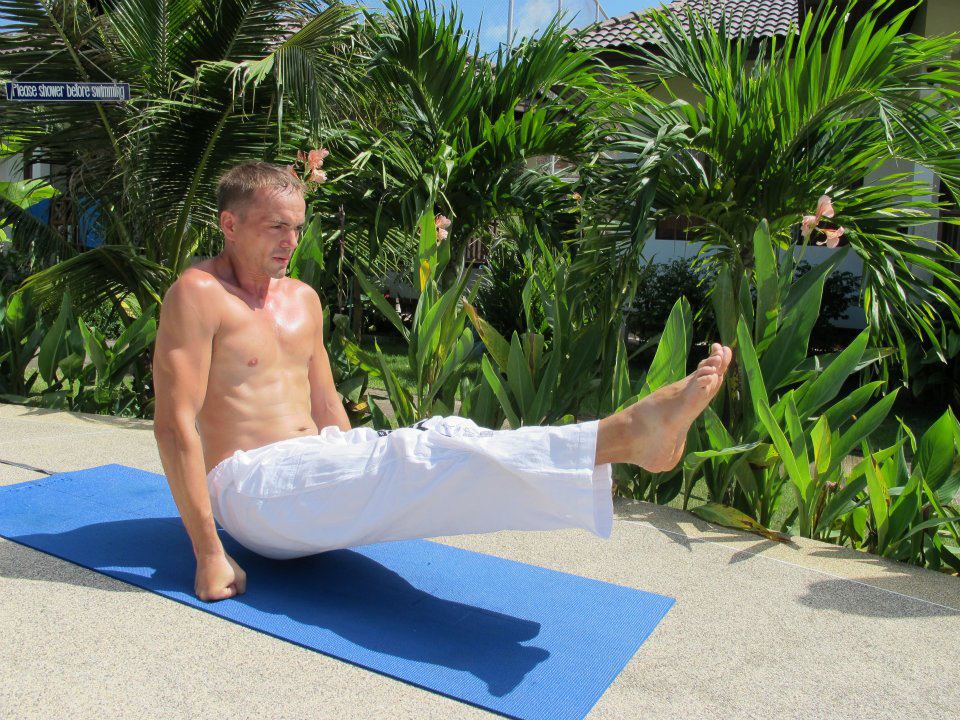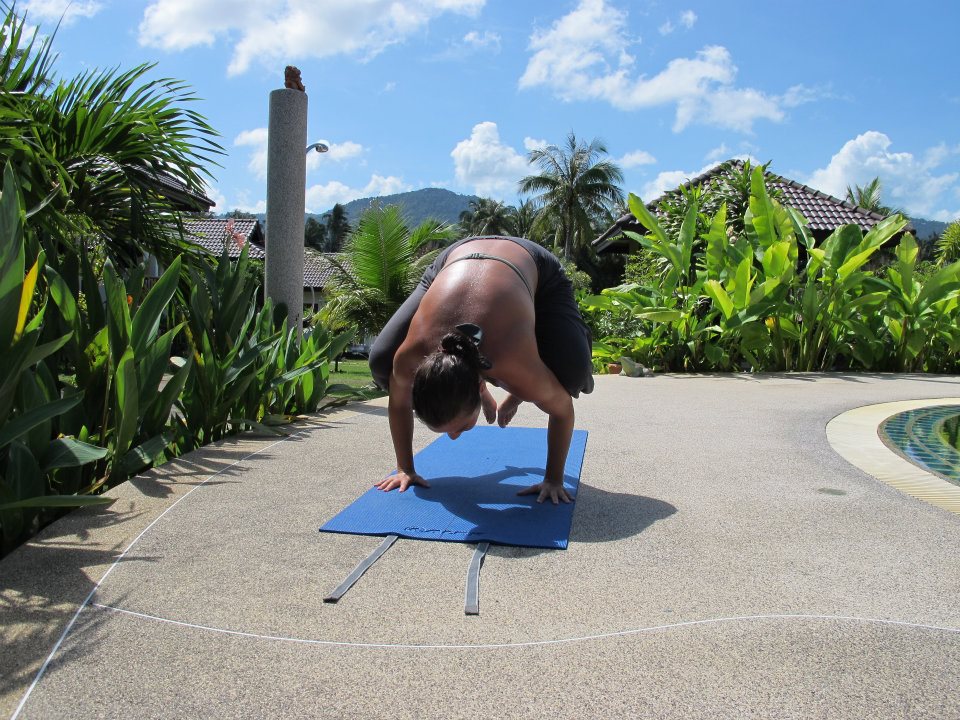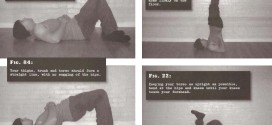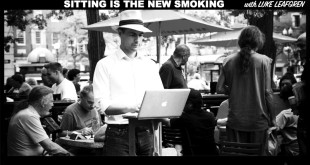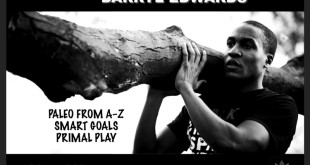“The Paleo-centric approach is really at the heart of our own personal practice too. From food and exercise, to growing our own vegetables, to rest and relaxation.”
We recently caught up with Stuart Daniels and Lorraine Biddle, the masterminds behind Primal Retreat, to talk about a whole host of topics including safe starches, low carb Paleo misconceptions, natural movement and, of course, Primal Retreat. This is part one of a two-part interview.
Stuart is Co-Founder and Fitness Trainer at Primal Retreat. He has been an avid health and fitness enthusiast for over 20 years. He has trained in a wide selection of martial arts for over 10 years including Muay Thai Kick Boxing, Kick Boxing, Tae Kwon Do, Aikido and Krav Maga. Stuart is currently training in Eskrima, which is a form of Filipino stick and knife fighting. Stuart is a MovNat Certified Trainer (MCT) and a Certified Ashtanga Vinyasa yoga teacher (RYA). He also enjoys running and weight lifting. Proudly Paleo since 2007.
Lorraine is Co-Founder and Fitness Trainer at Primal Retreat. She is a MovNat Certified Trainer (MCT) and a Certified Ashtanga Vinyasa yoga teacher (RYA). She has trained in Muay Thai Boxing in Thailand and ran the marathon in Taiwan. Other fitness interests include; kickboxing, boxing, weight lifting, walking, swimming & skiing. Proudly Paleo since 2007.
Firstly, thank you for joining us at Paleo Minds. Let’s start off by talking about what Primal Retreat is, where the idea came from and how it’s progressed since its initial launch.
SD: Lorraine and I both started eating a Paleo diet in 2006, about 8 years ago, when it was almost unheard of in the UK. We first got into it through following Arthur De Vany’s evolutionary fitness approach, then discovering more about his dietary approach. We then read everything we could find from other Paleo advocates including Robb Wolf, Mark Sisson, Loren Cordain, Chris Kresser and many others.
We have both always been pretty healthy and into fitness but we found through eating Paleo, our energy levels and sleep improved. I was an IT consultant for over 10 years and Lorraine was an Event Manager working in London.
In 2012, we wanted a change of scenery and so moved to Taiwan to study Chinese and start working on our own Internet Marketing businesses. We enjoyed 2 great years there, then decided it would be great to combine our passion for Paleo health and fitness, move back to the UK and start a Paleo fitness retreat.
So, in 2012 we founded Primal Retreat. Although Paleo was relatively unknown in the UK at the time, we have always found most of our customers were aware of Paleo and had already made some level of positive change in that direction. Occasionally we have people attend who don’t have that much knowledge of Paleo, but are usually pretty open minded. By the time they leave they feel the benefits.
Our Primal Retreats take an evolutionary approach to diet, exercise, sleep and rest. We do long walks, martial art fitness, natural movement, and yoga. There is lots of downtime to relax and we exercise for a maximum of 4.5 hours a day from low to high intensity.
By default we serve a low carb Paleo menu, but in the last year we have starting offering safe starches with evening meals as an option. These are sweet potatoes, white potatoes and white rice. We get many fit, lean and healthy customers, and safe starches are much more suitable for them.
Those new to Paleo and Ancestral Health movement may wonder what a ‘safe starch’ is and how it differs to other forms of starch. Could you briefly explain this and why if you’re fit, lean and healthy it’s actually advantageous to include safe starches within your meals?
SD: Safe Starch is any form of starch that when cooked/prepared properly doesn’t contain toxins, or greatly reduces them. There has been disagreement in the Paleo community with some claiming starch in itself is toxic. However, most of the well known gurus in the Paleo space no longer support this view and we feel the scientific evidence doesn’t support the claim. There are many healthy populations such as Okinawans and Kitavans around the world who consume large amounts of starch and appear relatively free of the metabolic issues seen in the West. Humans also have a number of copies of the amylase enzyme which breaks down starchy food into glucose. Health issues seen with grains are primarily caused by toxic proteins such as gluten, and not the starch content.
If you are fit, lean and healthy, then your macronutrient ratios should be down to personal choice. It’s all about finding the levels that suit your lifestyle. This might be based on activity levels, genes, goals, how you feel and a whole host more. No two people are alike, and while it might suit some people to be lower carb, for others higher levels might be more suitable. Tubers and white rice are good sources of safe starch.
Paul Jaminet and Chris Kresser are two great resources to discover more in this area.
Is labelling Paleo ‘low carb’ an inaccuracy that leads to confusion? We see it all the time and in terms of the conventional diet it is lower carb, but often outsiders to Paleo will see ‘low carb’ and confuse it with ‘no carb’.
SD: Yes, I believe it is an inaccuracy. Low Carb is just one type of Paleo diet that is good for rapid weight loss and beneficial for some health issues. However, it’s just not necessary for everyone, and there are plenty of people out there who have developed health problems from being very low carb for too long. The amount of carb intake is really dependant on the individual, the quality of carbs is the most important thing. I.e. Correctly eliminating or reducing the toxic ones.
How did you first become interested in a Paleo-centric approach to diet, fitness and lifestyle?
SD: We discovered Paleo by following Arthur De Vany’s Evolutionary Fitness approach. Short bouts of lifting weights, sprinting and so on. It’s pretty common knowledge now, but in 2006, the idea you could optimise your weights workouts by only training for 25–30 minutes was hardly known. We were able to get better results in half the time.
We then gave Art’s low carb Paleo approach a try and felt amazing. From there we became fascinated by the Paleo diet and everything ancestral. We would spend hours every day reading Paleo blogs and books, and listening to Paleo podcasts.
The Paleo-centric approach is really at the heart of our own personal practice too. From food and exercise, to growing our own vegetables, to rest and relaxation.
What is it about the location of Primal Retreat that complements the Paleo lifestyle so well?
SD: At the end of 2013, we bought a property in Woodbridge, Suffolk. It is a beautiful and peaceful place. We have the river, forest and beach all within a 10–20 minute drive away. This makes it an ideal place for outdoor training.
Our guided walks may include a beach walk, the UFO trail, a nature reserve and a river walk. They are all very scenic and picturesque.
Our natural movement classes are in the forest where there are lots of places to jump, balance, crawl, climb trees, sprint and hang. We love living here and using the facilities for our own personal training.
“Natural Movement should be an essential part of a fitness and exercise regime. In many ways it’s the ultimate anti-ageing workout.”
For those who book a Primal Retreat what does a typical day of food look like and are there options for those who have restrictions and sensitivities beyond Paleo?
SD: For breakfast, it will normally be some kind of eggs such as a frittata, omelette or fried eggs with vegetables.
For lunch, it is normally a big salad with some meat or fish, in the colder months it might be a homemade soup. For dinner, it will usually be meat/fish with vegetables. Safe starches such as white rice, potatoes and sweet potatoes are provided at dinner for those who want a higher carb menu.
We ask people before they come if there are any foods they are intolerant of or do not eat. We are then happy to provide substitutions for them. So it’s not a problem for those with special restrictions, and it’s pretty common to make a few substitutes per meal.
Can you expand on what is meant by ‘natural movement’ and why it has such tremendous fitness benefits?
SD: Natural Movement is playful exercise based around how our bodies are designed to move. The movement patterns we are all born with, but most of us lose them as we get older through lack of use or poor exercise routines that weaken our mobility.
Typical examples are running, jumping, climbing, crawling, lifting, balancing. Lessons are not very high intensity, but can be taxing as people start using muscles they haven’t used in a while.
Natural Movement should be an essential part of a fitness and exercise regime. In many ways it’s the ultimate anti-ageing workout. Even something such as balancing on a beam of wood resting on the ground can be a real challenge to some who hasn’t practised that skill. However, within a few days, we have attendees balancing 4 to 5 foot off the ground on beams, and they really get the importance of keeping these skills sharp and in focus.
 Paleo Minds Paleo diet, fitness and lifestyle.
Paleo Minds Paleo diet, fitness and lifestyle.
